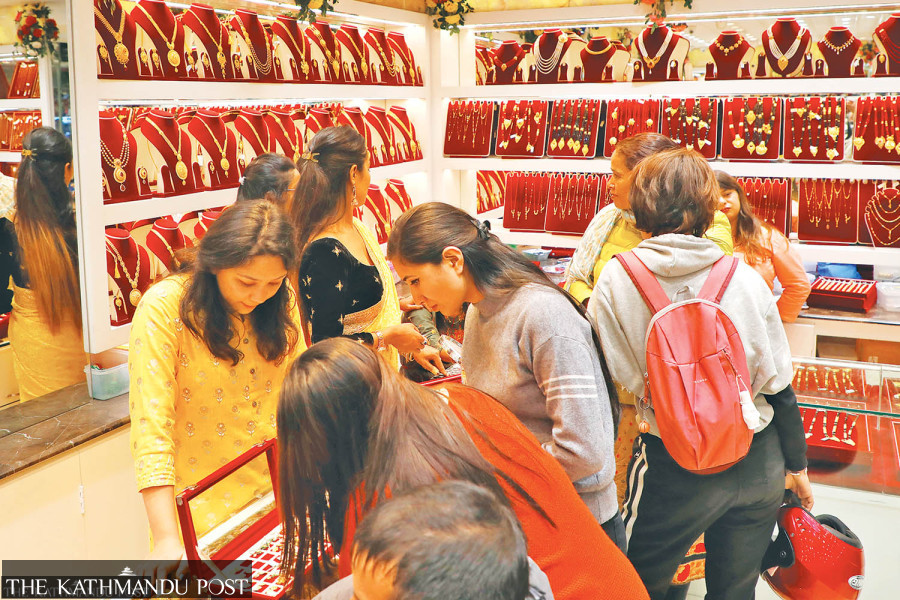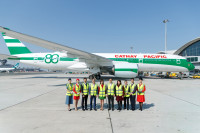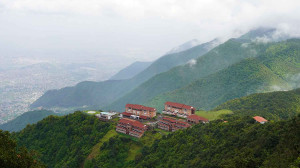Money
Customers shy away as gold price soars
The budget announced on Tuesday has increased the customs duty on the precious metal by five percent, which may push the price to a record Rs150,000 a tola.
Krishana Prasain
Amid the steady rise in the price of gold in the international market, the government has increased the customs duty on the yellow metal. Nepali bullion traders say gold may open at Rs150,000 a tola on Sunday.
The budget announced on Tuesday for the next fiscal year 2024-25, beginning mid-July, increased the customs duty on gold to 20 percent from the existing 15 percent, with immediate effect on Wednesday.
The price of gold went up by around Rs6,000 a tola. On Thursday, gold was traded at Rs140,500 per tola.
Last Friday, the domestic bullion market closed at Rs136,900 per tola.
On Sunday, the market opened at the same rate, which increased slightly to Rs137,200 a tola on Monday. The price further escalated to Rs137,600 per tola on Tuesday and to Rs138,200 on Wednesday.
The gold price has risen by Rs28,500 a tola within a year.
“The price of the precious yellow metal will reach Rs150,000 per tola in the domestic market after the new tax is adjusted,” said Diyesh Ratna Shakya, second vice-president of the Federation of Nepal Gold and Silver Dealers’ Association.
“If the price crosses Rs150,000, the trend of people selling their gold jewellery will increase to book profit,” he said.
Bullion traders say that the sale of gold jewellery declined by a third when the gold hit the six-digit mark in August 2020.
“Now, the price is so high that it is already beyond the buying capacity of many Nepali consumers,” said Shakya.
“The gold price on Thursday increased by around Rs6,000 a tola, but it seems that the price has not been adjusted accordingly, which might be due to the remaining stock in banks,” Shakya said.
In the international market, gold was traded at around $2,332.60 an ounce on Thursday.
The price of precious yellow metal has been breaking records in the international market for the past few months due to investors buying gold amid geopolitical uncertainty.
Gold is considered a resilient investment. When interest rates fall, gold prices tend to rise, as bullion becomes more appealing than income-paying assets like bonds.
Investors also see gold as a hedge against inflation, betting bullion will retain its value when prices rise.
Escalating tensions in the Middle East have stoked fears of geopolitical instability, prompting investors to seek refuge in the safe haven.
According to international media reports, the price of gold has surged over 10 percent since the start of the year, cementing its status as a preferred hedge against inflation and a sanctuary amid political and economic uncertainty.
This significant uptick is largely due to considerable purchases by central banks and a rising demand for safe-haven assets.
In Nepal, the gold price depends on international factors. In addition to international prices, which are denominated in dollars, import duties and other taxes also play a role in determining gold rates in Nepal.
The selling trend of gold by the customer was slightly increasing after the price crossed Rs125,000 per tola.
With gold in stock, banks are currently refraining from importing it, mainly due to high price and off-season for weddings, which typically spans from from mid-May to mid-June, bullion traders said.
According to the federation, currently, nearly 15 kilos of gold is being transacted by bullion traders daily.
Bullion traders add around 11 percent as making costs. So, if the price of a tola of gold is Rs140,000, then it will cost Rs155,000 for gold jewellery, and the price goes higher if precious stones are added, Shakya said.
Shakya said that the footfall of customers has been declining in gold jewellery shops.
The gold import has declined in quantity but increased in value.
According to the Department of Customs, gold imports increased by 11 percent to Rs21.65 billion in the first 10 months of the current fiscal year, which ended in mid-May, compared to the same period last fiscal year.
Quantity-wise, the import of gold declined to 2,451 kilos in the 10 months of the current fiscal year from 2,566 kilos in the review period.
Nepal imported 2,916 kilos of gold worth Rs22.35 billion in the last fiscal year. Gold is being mainly imported from the UAE and Turkey.




 13.05°C Kathmandu
13.05°C Kathmandu















